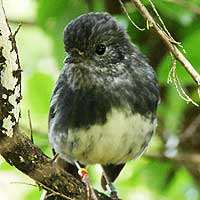Native birds feel no fear when facing foes

(PhysOrg.com) -- Endangered native birds are at risk of losing their instinct to recognise and flee mammalian enemies when moved between predator-free and predator-filled sites, says a Massey researcher.
Sarah Whitwell, a biology Masters student at Massey's Institute of Natural Resources in Albany, designed an experiment using a pulley system to dangle a stuffed stoat and morepork at nesting North Island robins to test their fear responses. She says most robins in areas free of introduced predators, such as stoats, failed to get into a flap at the sight of an enemy, albeit a fake version.
Her research adds to growing evidence that native birds' responses to mammalian predators are not genetically hard-wired.
“That's because introduced mammal predators have been here a relatively short time, whereas native birds have been here for millions of years.”
She says already endangered native bird species would be at increased risk if moved back to wilderness sites with mammalian predators after inhabiting mammal-free conservation areas without some form of predator-recognition training.
The responses of robins in predator-controlled Wenderholm Reserve and Tiritiri Matangi Island near Auckland were compared with those in the central North Island, where the birds have long co-existed with native and introduced predators.
Most of the robins in the predator-free zones did not react to the presence of the stuffed stoat but did react strongly to the morepork - a native predator with a long history of association with the robins. Real versions of both of these predators prey on native birds and their eggs and chicks.
Those in central North Island forest patches near Bennydale reacted to the stoat model by either flying away, or when there were eggs or chicks in their nests, by hopping, flicking or spreading their wings. In some cases, they called out to attract other birds to create a ruckus designed to scare the enemy.
“The birds at Bennydale could recognise the stoat because it's a predator they probably deal with on a regular basis. But those on Tiritiri Matangi who have been isolated from stoats for at least one generation have lost the ability to recognise the stoat as a result of isolation from them,” she says.
A number of endangered native New Zealand bird species - including kakariki, bellbirds and saddle-backs - now thriving in protected conservation offshore islands are being moved back to areas inhabited by predators in a bid to increase the population spread and gene pool.
“My research suggests there might be a need for birds from mammal-free areas to undergo pre-release training in predator recognition,” says Ms Whitwell.
This could be done by mixing birds from predator-free areas with birds capable of recognising predators in an enclosure, then using a mock predator to prompt a fear reaction. Fearless birds would model new behaviour by witnessing the response of birds whose fear instinct was active, she says.
She says although the stoat and morepork in her experiments were not real, they are still convincing enough to prompt real fear responses from the birds.
Provided by Massey University


















